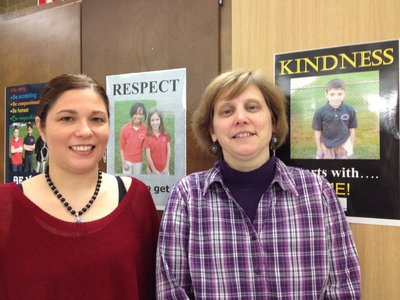The hallways of Clarendon Elementary School are full of posters displaying the school’s students, along with messages such as, “Respect and trust build friendships,” and “Never give up.”
Are these attempts at character-building making a difference?
“The kids are getting excited because they are looking for themselves [in the hallways],” said special education teacher Felicia Maloney last week. “The kids stop and see themselves but then they read the messages.”
A teacher at Clarendon of 29 years and advisor to the student government, Maloney last fall photographed every student whose parents signed a release form. She said Principal Pat Cocucci initiated the project. It’s part of a broader collaborative effort related to character education and anti-bullying coordinated by Maloney, Guidance Counselor Dawn Doering, first grade teacher Connie Boruch, and fifth grade teacher Marietta Amato.
Building character
“We have been doing character education for at least five or six years in Clarendon,” said Boruch. An educator of 25 years, she is on the “anti-bullying team.”
Character education consists of six pillars: trustworthiness, respect, responsibility, fairness, caring, and citizenship. Students have also come up with suggestions for quotes and ideas for the posters.
Secaucus is part of the Hudson County Consortium for Emotional Social Learning. The consortium promotes individual student well-being, safety and security, and works to improve climate and culture. Boruch said that the educators at Clarendon have been successful in establishing a positive social and emotional climate at the school because students feel safe, are happy and look out for one another.
“We want to get to the point when kids come to school and there is no bullying.” – Connie Boruch.
__________
School conducts ‘bullying investigations’
Boruch said the character education work includes anti-bullying lessons that have come about as a result of statewide anti-bullying legislation passed two years ago. The Harassment, Intimidation, and Bullying law establishes a framework to support the prevention, remediation, and reporting of bullying in schools across the state among other policies.
“The hardest part is knowing what is bullying and knowing what is normal conflict,” said Boruch. She said that everyone at Clarendon was trained by the NJ State Bar Association and received what are called Bully Buster Lessons. Educators teach a Bully Buster Lesson every month at their grade level. The first lesson teaches about the distinctions between bullying and normal conflict.
“Arguing is not necessarily bullying,” said Boruch. She said that the law states that bullying happens for a specific reason and is discriminatory.
Clarendon has had less than five bullying investigations in the past year.
“We get an incident report and we investigate if someone believes it is bullying,” said Doering. An educator of 15 years, she is the school’s anti-bullying specialist. “Nothing has been found to be actual bullying.” Doering said the key is prevention.
“I talk to a lot of kids everyday. They get it. They know the difference between what is bullying and what is conflict.”
Amato teaches the fifth grade and is the advisor to the media club. She has been a teacher for 15 years. She said that anti-bullying lessons come up every day.
“There is always discussion. There are always teachable moments,” said Amato. Amato led the media club in creating a public service announcement about bullying. She said the group used role-play to demonstrate what bullying is.
Recognizing kindness too
Clarendon last year held an anti-bullying rally and took an anti-bullying pledge. The kids also performed plays and skits.
Boruch said that since the school has a good grasp on knowing not to bully, they have moved on to looking at positive messages and actions.
“We are moving away from the negatives and into the positives,” said Boruch.
She said that children are rewarded for acts of kindness and acts of charity.
“Two kindergarten girls last year…were picking up garbage in the playground every morning,” said Boruch who noticed the girls early in the mornings before school began. She made a point of recognizing their effort.
‘Fill a Bucket’
Next academic school year, Doering will launch a new character education program called “Fill a Bucket.” Filling a bucket has to do with being a good citizen who cares for and respects others. Educators will encourage students to be helpful, unselfish, and compassionate. Buckets represent a child’s emotional well-being. A full bucket equals happiness while an empty bucket equals sadness. Bucket “fillers” are individuals who are helpful, kind, caring, and spread love and compassion. Bucket “dippers” are individuals who rob others of their happiness by acting negatively.
Boruch said “We want to get to the point when kids come to school and there is no bullying.”
